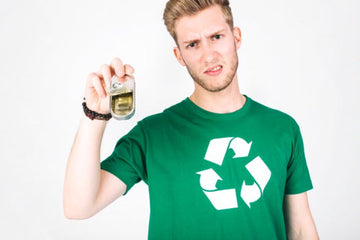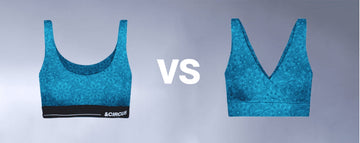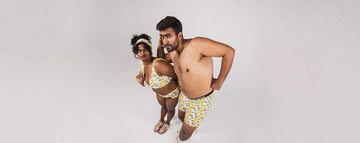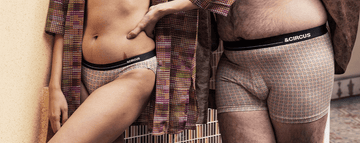Quick Listen:
Picture this: you slip into a pair of soft, breathable underwear or cozy loungewear, knowing that when their time is up, they won't linger in a landfill for centuries. Instead, they'll gently return to the earth, leaving barely a trace. This isn't a far-off dream it's the promise of biodegradable fabrics, a quiet revolution reshaping the fashion world. As consumers grow weary of fast fashion's environmental toll, brands like AndCircus are stepping up, weaving sustainability into the very threads of daily wear.
Uncomfortable underwear shouldn't steal your confidence. At Andcircus, we craft ultra-soft, sustainable Lenzing Modal Micro® innerwear for every body, XS to 5XL. From briefs to bras, our custom packs fit you perfectly. Shop risk-free with our 100% satisfaction guarantee and embrace comfort that includes everyone. #LoveEveryBody. Shop Now!
Embracing the Future of Fashion
In a world drowning in plastic waste, the rise of biodegradable materials feels like a breath of fresh air. These fabrics made from natural materials like hemp, linen, cotton, or innovative synthetics like polylactic acid (PLA) can decompose naturally under the right conditions, unlike traditional polyester or nylon. According to a report from Congruence Market Insights, the global biodegradable fabrics market was valued at $5.17 billion in 2022 and is expected to soar to $14.39 billion by 2030, growing at a compound annual growth rate (CAGR) of 13.7%. This surge reflects a broader shift: consumers aren't just buying clothes; they're investing in a healthier planet.
AndCircus, a brand specializing in eco-friendly and inclusive underwear and loungewear, is riding this wave. Their commitment to biodegradable materials isn't just a marketing pitch it's a core ethos. By using fabrics like organic cotton and bamboo, they're crafting garments that feel good on your skin and tread lightly on the earth. It's a small but meaningful step toward dismantling the fashion industry's reputation as an environmental villain.
Innovations Driving Change
The science behind biodegradable fabrics is as fascinating as it is hopeful. Plant-based fibers like hemp and linen have been around for centuries, but new players like mycelium (derived from mushrooms) and algae-based textiles are pushing boundaries. These materials aren't just sustainable; they're versatile, finding their way into everything from medical products to chic loungewear. A Grand View Research report pegs the bio-based textiles market at $49.84 billion in 2024, projecting growth to $81.31 billion by 2030 at a CAGR of 8.5%. Plant-based materials, which dominated with a 63.9% revenue share in 2024, are leading the charge, particularly in apparel.
Technology is making these fabrics tougher and more practical for everyday use. Innovations in processing have improved durability, ensuring that biodegradable underwear or lounge pants can withstand the rigors of daily life. For AndCircus, this means offering products that don't just check the eco-box but also deliver on comfort and style. It's a balancing act creating fabrics that decompose gracefully but don't fall apart in the wash.
Real-World Impact
AndCircus is a standout in this space, weaving biodegradable materials into their inclusive designs. Their underwear, crafted from natural fibers like cotton and bamboo, is designed to fit diverse bodies while minimizing environmental harm. But they're not alone. Other brands are catching on, from small-scale designers to global names rolling out collections made with PLA or cellulose-based fabrics. Coherent Market Insights notes that the biodegradable fabrics market is expected to hit $13.65 billion by 2032, driven by demand for eco-friendly clothing, furnishings, and even packaging.
Take the case of a European brand that recently launched a line of biodegradable activewear. By using PLA, they cut their carbon footprint significantly while maintaining performance standards. The result? A collection that sold out in weeks, proving that sustainability can be a selling point. For AndCircus, the focus on daily wear like loungewear taps into a growing consumer desire for comfort with a conscience. These success stories show that biodegradable fabrics aren't just a niche trend they're becoming a cornerstone of modern fashion.
Hurdles on the Horizon
Yet, the path to a biodegradable future isn't without bumps. Durability remains a concern. While advancements have made these fabrics more robust, some worry they won't hold up as well as their synthetic counterparts over years of wear. Then there's the cost. Producing biodegradable materials, especially at scale, is pricier than churning out conventional polyester. This can translate to higher price tags, which not all consumers are ready to embrace.
Education is another hurdle. Many shoppers don't yet grasp the difference between biodegradable and traditional fabrics or why it matters. Brands like AndCircus face the task of not just selling clothes but also telling a story one that connects the dots between a pair of underwear and a cleaner planet. Supply chain issues add another layer of complexity. Sourcing sustainable materials in large quantities while ensuring ethical practices isn't easy, especially when global demand is skyrocketing.
Opportunities for Growth Despite these challenges, the opportunities are immense. For brands like AndCircus, biodegradable materials are a way to stand out in a crowded market. In a 2024 survey cited by Grand View Research, 47.3% of the bio-based textiles market share came from Asia Pacific, where consumer demand for sustainable fashion is surging. By leaning into eco-friendly practices, brands can capture this growing audience, fostering loyalty among shoppers who prioritize values over price. The environmental payoff is significant. Unlike traditional textiles, which can take centuries to break down, biodegradable fabrics decompose naturally, reducing landfill waste. The Grand View Research report on biodegradable plastics highlights a parallel trend: the packaging sector, which held a 53.91% revenue share in 2023, shows how biodegradable materials can slashed waste across industries. For fashion, this means less pollution and a smaller carbon footprint a win for both brands and the planet. Innovation is another bright spot.
Researchers are exploring ways to enhance biodegradability without sacrificing performance, from stronger plant-based fibers to bioengineered textiles that break down faster. For AndCircus, this could mean even softer, longer-lasting loungewear that still returns to the earth when its lifecycle ends. A Greener Tomorrow Fashion sustainability experts are optimistic. “Biodegradable materials are a game-changer,” says one industry analyst, pointing to their potential to reshape how we think about clothing. “In five to ten years, we could see these fabrics dominate the market as technology improves and costs come down.” The numbers back this up: with the biodegradable fabrics market projected to grow at a 12.8% CAGR through 2032, per Coherent Market Insights, the future looks green. For now, brands like AndCircus are leading the charge, proving that sustainability doesn't mean sacrificing style or comfort. Their underwear and loungewear aren't just garments they're a statement about what fashion can be: inclusive, eco-conscious, and forward-thinking. As consumers, we have a choice: stick with the status quo or embrace brands that are stitching a better future, one biodegradable thread at a time. The next time you slip into a pair of eco-friendly pajamas, you're not just getting cozy you're joining a movement.
Frequently Asked Questions
What are biodegradable fabrics and how do they differ from traditional materials?
Biodegradable fabrics are made from natural materials like hemp, linen, organic cotton, bamboo, or innovative synthetics like polylactic acid (PLA) that can decompose naturally under the right conditions. Unlike traditional polyester or nylon that can linger in landfills for centuries, biodegradable materials gently return to the earth, leaving minimal environmental impact while offering the same comfort and style as conventional fabrics.
Are biodegradable underwear and loungewear as durable as regular clothing?
While early biodegradable fabrics had durability concerns, recent technological innovations have significantly improved their strength and longevity. Modern biodegradable underwear and loungewear, like those made by brands such as AndCircus using organic cotton and bamboo, are designed to withstand daily wear and washing while maintaining their eco-friendly decomposition properties. The key is balancing durability for everyday use with the ability to break down naturally at the end of their lifecycle.
Why are biodegradable fabrics more expensive than conventional clothing materials?
Biodegradable fabrics typically cost more due to the higher production costs involved in sourcing sustainable materials and the specialized processing required to create these eco-friendly textiles. The biodegradable fabrics market, valued at $5.17 billion in 2022, is still scaling up production, which keeps costs higher than mass-produced synthetic materials. However, as demand grows and technology advances, prices are expected to decrease while offering long-term environmental benefits that justify the investment.
Disclaimer: The above helpful resources content contains personal opinions and experiences. The information provided is for general knowledge and does not constitute professional advice.
You may also be interested in: Why Body-Positive Brands Are Reshaping Innerwear Trends
Uncomfortable underwear shouldn't steal your confidence. At Andcircus, we craft ultra-soft, sustainable Lenzing Micro Modal innerwear for every body, XS to 5XL. From briefs to bras, our custom packs fit you perfectly. Shop risk-free with our 100% satisfaction guarantee and embrace comfort that includes everyone. #LoveEveryBody. Shop Now!







































